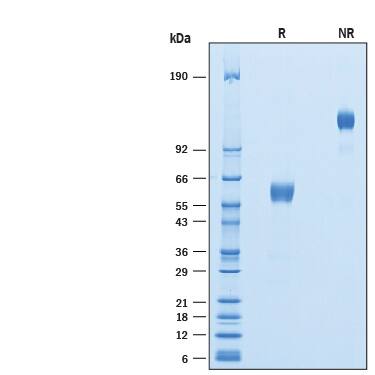Recombinant Human Frizzled-8 Fc Biotinylated Protein, CF
R&D Systems, part of Bio-Techne | Catalog # BT6129

Key Product Details
Source
Accession #
Structure / Form
Conjugate
Applications
Product Specifications
Source
| Human Frizzled-8 (Ala25-Pro172) Accession # Q9H461 |
IEGRMD | Human IgG1 (Pro100-Lys330) |
| N-terminus | C-terminus |
Purity
Endotoxin Level
N-terminal Sequence Analysis
Predicted Molecular Mass
SDS-PAGE
Activity
When Recombinant Human Wnt‑3a (Catalog # 5036-WN) is immobilized at 1 µg/mL (100 µL/well), Biotinylated Recombinant Human Frizzled‑8 Fc Chimera (Catalog # BT6129) binds with an ED50 of 0.5-3 μg/mL.
Scientific Data Images for Recombinant Human Frizzled-8 Fc Biotinylated Protein, CF
Recombinant Human Frizzled-8 Fc Biotinylated Protein Binding Activity
When Recombinant Human Wnt-3a (Catalog # 5036-WN) is immobilized at 1 µg/mL (100 µL/well), Biotinylated Recombinant Human Frizzled-8 Fc Chimera (Catalog # BT6129) binds with an ED50 of 0.5-3 µg/mL.Recombinant Human Frizzled-8 Fc Biotinylated Protein SDS-PAGE
2 μg/lane of Biotinylated Recombinant Human Frizzled-8 Fc Chimera (Catalog # BT6129) was resolved with SDS-PAGE under reducing (R) and non-reducing (NR) conditions and visualized by Coomassie® Blue staining, showing bands at 53-63 kDa and 110-130 kDa, respectively.Formulation, Preparation and Storage
BT6129
| Formulation | Lyophilized from a 0.2 μm filtered solution in PBS with Trehalose. |
| Reconstitution | Reconstitute at 500 μg/mL in PBS. |
| Shipping | The product is shipped at ambient temperature. Upon receipt, store it immediately at the temperature recommended below. |
| Stability & Storage | Use a manual defrost freezer and avoid repeated freeze-thaw cycles.
|
Background: Frizzled-8
Frizzled-8 is one of at least ten seven-transmembrane (7TM) glycoproteins of the Frizzled family of Wnt receptors (1-2). Frizzled proteins are thought to be G-protein-coupled (1). Wnt engagement, with low density lipoprotein receptor-related proteins LRP-5 or LRP-6 acting as co-receptors, stabilizes beta-catenin and promotes gene transcription that is important in development and tissue maintenance (1). Human Frizzled-8 cDNA encodes 694 amino acids (aa) including a 27 aa signal peptide, a 247 aa extracellular domain (ECD), the 7TM region (aa 276-605), and a C-terminal cytoplasmic domain with a PDZ binding motif (aa 606-694) (2). The ECD includes a cysteine-rich region (CRD, aa 30-151) that binds Wnts and is highly conserved among Frizzleds, and a linker region. Within aa 28-172, human Frizzled-8 shares 99%, 99%, 90% and 85% aa identity with mouse, rat, Xenopus and zebrafish Frizzled-8, respectively. It also shares 82% aa identity with human Frizzled-5. Frizzleds can form homodimers or selective hetero-oligomers with other family members, which can involve the TM regions and possibly the CRD (1, 3). During mouse development, Frizzled-8 is expressed in tissues that are important for organizing the anterior-posterior axis (4). Interactions of Frizzled-8 with several non-Wnt ligands have been identified. Interaction with Frizzled-8 and LRP-6 allows R-spondins to activate beta-catenin signaling pathways, while interaction with IGFBP-4 (insulin-like growth factor binding protein (4) or CTGF (connective tissue growth factor) inhibits Wnt signaling (5-7). These ligands bind the extracellular CRD of Frizzled-8, blocking Wnt binding. The recombinant Frizzled-8 CRD has also been used to block Wnt signaling and inhibit growth of teratocarcinomas (5-10).
References
- Schulte, G. and V. Bryja (2007) Trends Pharmacol. Sci. 28:518.
- Saitoh, T. et al. (2001) Int. J. Oncol. 18:991.
- Dann, C.E. et al. (2001) Nature 412:86.
- Lu C.C. et al. (2004) Gene Expr. Patterns 4:569.
- Nam, J-S. et al. (2006) J. Biol. Chem. 281:13247.
- Zhu, W. et al. (2008) Nature 454:345.
- Mercurio, S. et al. (2004) Development 131:2137.
- Chesnutt, C. et al. (2004) Dev. Biol. 274:334.
- Yamashita, J.K. et al. (2005) FASEB J. 19:1534.
- DeAlmeida, V.I. et al. (2007) Cancer Res. 67:5371.
Alternate Names
Gene Symbol
UniProt
Additional Frizzled-8 Products
Product Documents for Recombinant Human Frizzled-8 Fc Biotinylated Protein, CF
Product Specific Notices for Recombinant Human Frizzled-8 Fc Biotinylated Protein, CF
For research use only

